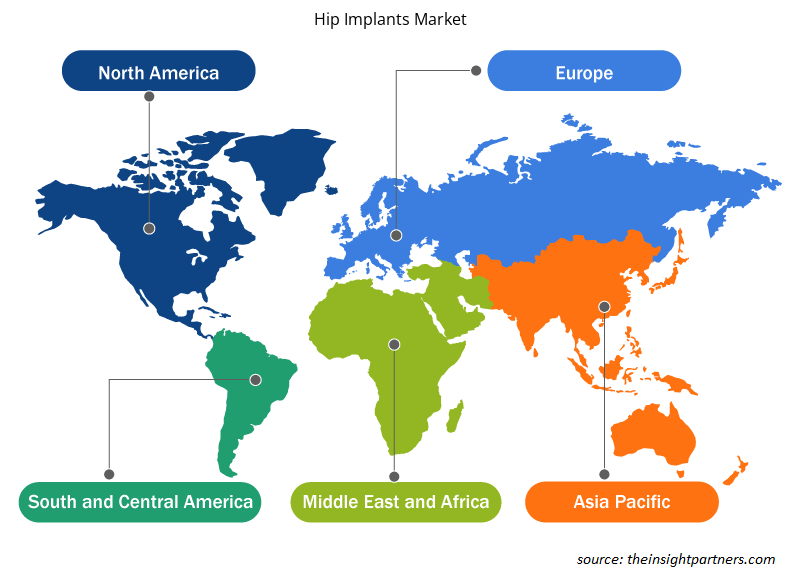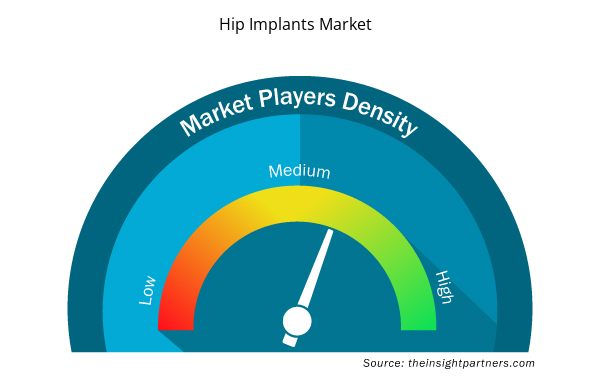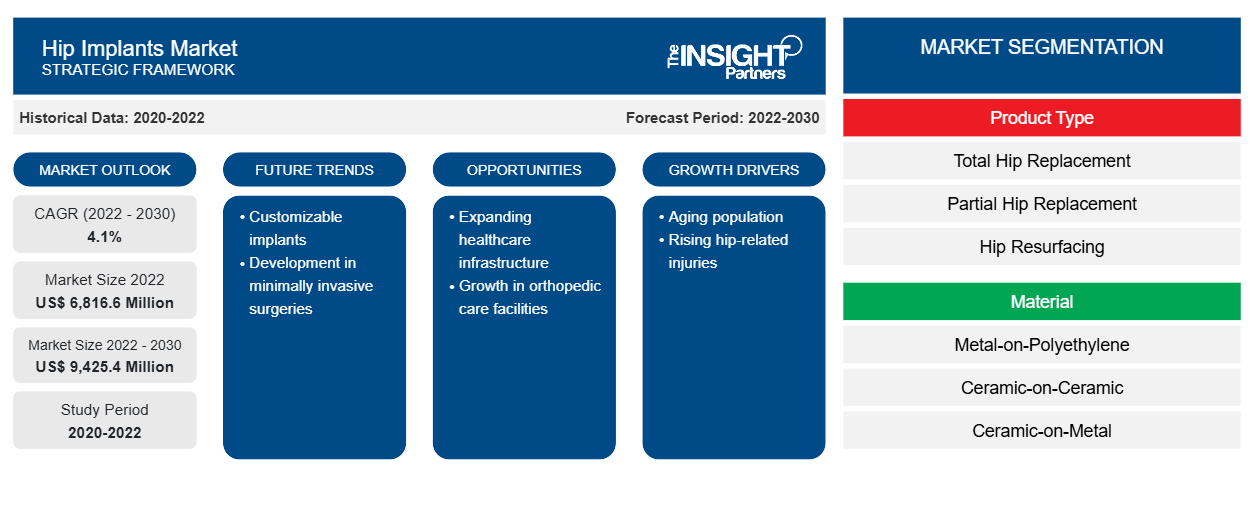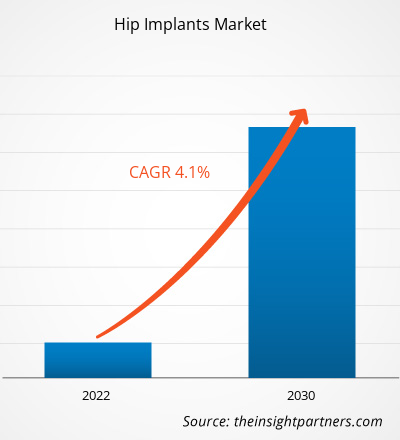[Rapporto di ricerca] Si prevede che il mercato degli impianti all'anca crescerà da 6.816,6 milioni di dollari nel 2022 a 9.425,4 milioni di dollari entro il 2030; si prevede che registrerà un CAGR del 4,1% dal 2022 al 2030.
Approfondimenti di mercato e opinioni degli analisti:
Le dimensioni del mercato degli impianti all'anca stanno crescendo rapidamente a causa dell'aumento di interventi chirurgici all'anca, lesioni all'anca, osteoartrite e artrite reumatoide. Inoltre, le iniziative strategiche delle aziende per rimanere competitive stanno alimentando la crescita del mercato. Ad esempio, Smith & Nephew ha lanciato OR3O Dual Mobility System in India nell'agosto 2023 per l'artroplastica primaria e di revisione dell'anca. OR3O include la superficie di appoggio avanzata di Smith & Nephew, OXINIUM DH, grazie al suo rivestimento e all'OXINIUM proprietario su XLPE. Ciò elimina sia il rivestimento modulare CoCr che la testa sferica CoCr dalla struttura, riducendo i rischi di usura e corrosione associati alla lega. Pertanto, un aumento significativo delle tecnologie rivoluzionarie per soddisfare le esigenze dei clienti probabilmente porterà nuove tendenze nelle previsioni di mercato degli impianti all'anca.
Fattori di crescita e sfide:
Secondo l'Osteoarthritis Action Alliance, l'osteoartrite è una delle forme di artrite più comuni negli Stati Uniti, che colpisce circa 32,5 milioni di persone, di cui il 43% della popolazione aveva più di 65 anni nel 2020. Secondo i Centers for Disease Control and Prevention, circa il 23% della popolazione statunitense soffriva di artrite nel 2020. Secondo Arthritis Research Canada, si stima che oltre 6 milioni di canadesi soffrano di osteoartrite, che si prevede saranno 10,5 milioni entro il 2040. L'osteoartrite può causare lesioni e fratture dell'anca poiché la densità ossea nei pazienti affetti da artrite è inferiore rispetto a coloro che non soffrono di artrite.
L'Organizzazione Mondiale della Sanità (OMS) ha stimato che la popolazione di età superiore ai 60 anni era di 1 miliardo nel 2019, che dovrebbe raggiungere 1,4 miliardi entro il 2030 e 2,1 miliardi entro il 2050. Si prevede che la quota di popolazione geriatrica aumenterà da circa il 15% a circa il 24% durante questo periodo. Secondo un altro rapporto di Eurostat, l'Europa ha avuto la percentuale più alta al mondo (20,8%) di persone di età superiore ai 60 anni nel 2021. Inoltre, entro il 2050, in tutte le regioni tranne l'Africa, oltre il 25% della loro popolazione avrà superato i 60 anni. Pertanto, l'aumento della popolazione geriatrica ha aumentato la prevalenza di varie condizioni ortopediche, come lesioni all'anca, osteoartrite e lussazione dell'anca dovute a cadute e altri sfortunati incidenti, con conseguente crescita del mercato degli impianti all'anca.
Personalizza questo report in base alle tue esigenze
Riceverai la personalizzazione gratuita di qualsiasi report, comprese parti di questo report, o analisi a livello nazionale, pacchetto dati Excel, oltre a usufruire di grandi offerte e sconti per start-up e università
- Scopri le principali tendenze di mercato in questo rapporto.Questo campione GRATUITO includerà analisi di dati che spaziano dalle tendenze di mercato alle stime e alle previsioni.
Segmentazione e ambito del report:
Il mercato degli impianti all'anca è suddiviso in base al tipo di prodotto, al materiale, all'utente finale e alla geografia. In base al tipo di prodotto, il mercato è suddiviso in sostituzione totale, sostituzione parziale, resurfacing dell'anca e revisione degli impianti all'anca. In base al materiale, il mercato è suddiviso in metallo su polietilene, ceramica su ceramica, ceramica su metallo, ceramica su polietilene e altri. In base all'utente finale, il mercato è suddiviso in ospedali, cliniche ortopediche, centri chirurgici ambulatoriali e altri. In base alla geografia, è suddiviso in Nord America (Stati Uniti, Canada e Messico), Europa (Regno Unito, Germania, Francia, Italia, Spagna, Russia e resto d'Europa), Asia Pacifico (Cina, Giappone, India, Corea del Sud, Australia e resto dell'Asia Pacifico), Medio Oriente e Africa (Emirati Arabi Uniti, Arabia Saudita, Sudafrica e resto del Medio Oriente e Africa) e America meridionale e centrale (Brasile, Argentina e resto dell'America meridionale e centrale).
Analisi segmentale:
L'analisi del mercato degli impianti dell'anca, per tipo di prodotto, è segmentata in ricostruzione femorale, ricostruzione acetabolare, resurfacing dell'anca, impianti dell'anca di revisione, tecnologie di cuscinetti e metallo poroso e impianti di sostituzione totale. Nel 2022, il segmento degli impianti di sostituzione totale ha detenuto la quota di mercato degli impianti dell'anca più grande e si prevede che registrerà il CAGR più elevato nel periodo 2022-2030.
In base al materiale, il mercato è segmentato in metallo su polietilene, ceramica su ceramica, ceramica su metallo e ceramica su polietilene. Nel 2022, il segmento metallo su plastica ha detenuto la quota di mercato più grande degli impianti per l'anca e si prevede che registrerà il CAGR più elevato nelle previsioni di mercato degli impianti per l'anca dal 2022 al 2030. La crescita del segmento è guidata da vantaggi quali risultati precisi, durata e rapporto costi-efficacia. Inoltre, altri vantaggi, quali minori complicazioni, progressi tecnologici e minori particelle di usura, alimentano la domanda di impianti per l'anca basati su metallo su plastica.
In base all'utente finale, il mercato è segmentato in ospedali, cliniche ortopediche, centri chirurgici ambulatoriali e altri. Nel 2022, il segmento ospedaliero ha detenuto la quota di mercato più grande degli impianti all'anca e si prevede che registrerà il CAGR più elevato nel periodo 2022-2030. Il crescente numero di interventi chirurgici per impianti all'anca negli ospedali sta guidando la crescita del segmento degli impianti all'anca in tutto il mondo. Inoltre, il personale ospedaliero è ben istruito e consapevole delle complicazioni che possono verificarsi durante o dopo il tipo di intervento chirurgico. Il personale ospedaliero è formato per affrontare le emergenze e fornire un'assistenza equilibrata al paziente. Anche le procedure di rimborso per gli interventi chirurgici sono facilmente disponibili e possono essere gestite dalla direzione ospedaliera. Inoltre, il crescente numero di ospedali in tutto il mondo probabilmente manterrà il predominio del segmento e sfrutterà la crescita del mercato degli impianti all'anca durante il periodo di previsione. Inoltre, il crescente numero di ospedali in tutto il mondo probabilmente manterrà il predominio del segmento.
Analisi regionale:
Geograficamente, il rapporto sul mercato degli impianti all'anca è suddiviso in Nord America, Europa, Asia Pacifico, Medio Oriente e Africa e Sud e Centro America. Il Nord America è il maggiore contributore alla crescita del mercato globale degli impianti all'anca. Si prevede che l'Asia Pacifico mostrerà il CAGR più elevato nelle previsioni di mercato degli impianti all'anca dal 2022 al 2030. La crescente incidenza di impianti all'anca, lanci di prodotti e infortuni sportivi all'anca guidano principalmente la crescita del mercato negli Stati Uniti. Secondo l'articolo "Hip Fracture Care and National Systems", pubblicato da Wolters Kluwer Health, Inc., circa 250.000-300.000 persone negli Stati Uniti vengono ricoverate in ospedale per fratture dell'anca ogni anno. Si stima inoltre che circa 500.000 persone saranno assistite da professionisti medici a causa di fratture dell'anca entro il 2040. Secondo l'American Academy of Orthopaedic Surgeons, le persone di età pari o superiore a 65 anni sono soggette a fratture dell'anca a causa di cadute in famiglia o nella comunità negli Stati Uniti. Secondo l'articolo "Hip Overview" pubblicato in National Library Medicine, i pazienti spendono circa 40.000 $ USA nel primo anno dopo una frattura dell'anca e il costo totale delle cure per le fratture dell'anca negli Stati Uniti ammonta a quasi 17 miliardi di $ USA all'anno. Pertanto, la crescente prevalenza di fratture dell'anca e lesioni dell'anca negli Stati Uniti e l'aumento della spesa per il trattamento di queste lesioni sono l'attuale tendenza del mercato degli impianti all'anca negli Stati Uniti.
Approfondimenti regionali sul mercato degli impianti dell'anca
Le tendenze regionali e i fattori che influenzano il mercato degli impianti dell'anca durante il periodo di previsione sono stati ampiamente spiegati dagli analisti di Insight Partners. Questa sezione discute anche i segmenti e la geografia del mercato degli impianti dell'anca in Nord America, Europa, Asia Pacifico, Medio Oriente e Africa e America centrale e meridionale.

- Ottieni i dati specifici regionali per il mercato degli impianti dell'anca
Ambito del rapporto di mercato sugli impianti dell'anca
| Attributo del report | Dettagli |
|---|---|
| Dimensioni del mercato nel 2022 | 6.816,6 milioni di dollari USA |
| Dimensioni del mercato entro il 2030 | 9.425,4 milioni di dollari USA |
| CAGR globale (2022-2030) | 4,1% |
| Dati storici | 2020-2022 |
| Periodo di previsione | 2022-2030 |
| Segmenti coperti | Per tipo di prodotto
|
| Regioni e Paesi coperti | America del Nord
|
| Leader di mercato e profili aziendali chiave |
|
Densità degli operatori del mercato degli impianti all'anca: comprendere il suo impatto sulle dinamiche aziendali
Il mercato degli impianti dell'anca sta crescendo rapidamente, spinto dalla crescente domanda degli utenti finali dovuta a fattori quali l'evoluzione delle preferenze dei consumatori, i progressi tecnologici e una maggiore consapevolezza dei benefici del prodotto. Con l'aumento della domanda, le aziende stanno ampliando le loro offerte, innovando per soddisfare le esigenze dei consumatori e capitalizzando sulle tendenze emergenti, il che alimenta ulteriormente la crescita del mercato.
La densità degli operatori di mercato si riferisce alla distribuzione di aziende o società che operano in un particolare mercato o settore. Indica quanti concorrenti (operatori di mercato) sono presenti in un dato spazio di mercato in relazione alle sue dimensioni o al valore di mercato totale.
Le principali aziende che operano nel mercato degli impianti all'anca sono:
- Fabbro e nipote
- Esattotech
- Zimmer Biomet
- Società per azioni Stryker
- DJO chirurgico (Enovis)
Disclaimer : le aziende elencate sopra non sono classificate secondo un ordine particolare.

- Ottieni una panoramica dei principali attori del mercato degli impianti dell'anca
Sviluppi del settore e opportunità future:
Di seguito sono elencati vari piani dei principali attori che operano nel mercato degli impianti all'anca:
- Ad agosto 2022, Exatech ha lanciato commercialmente un nuovo sistema di artroplastica totale dell'anca composto da Spartan Stem e Logical Cup. Spartan Hip Stem riflette le esigenze dei pazienti contemporanei e i più recenti progressi nell'approccio chirurgico. Logical Cup è un sistema acetabolare modulare avanzato progettato per soddisfare le esigenze dei pazienti altamente attivi, consentendo al contempo un processo chirurgico efficiente negli ospedali e nei centri chirurgici ambulatoriali.
- Smith & Nephew ha lanciato OR3O Dual Mobility System a settembre 2022 per l'artroplastica primaria e di revisione dell'anca in Giappone. Questa superficie di appoggio avanzata, OXINIUM DH, è utilizzata per il suo OXINIUM lineare e proprietario su XLPE per i suoi inserti in polietilene e la testa femorale.
Scenario competitivo e aziende chiave:
Alcuni dei principali attori trattati nel rapporto di mercato sugli impianti dell'anca sono Smith & Nephew, Exactech, Zimmer Biomet, Stryker Corporation, DJO Surgical (Enovis), Medacta, Conformis, DePuy Orthopaedics, MicroPort Orthopedics e Symbios. Queste aziende si concentrano su espansioni geografiche e lanci di nuovi prodotti per soddisfare la crescente domanda dei consumatori in tutto il mondo e aumentare la loro gamma di prodotti nei portafogli specializzati. La loro presenza globale consente loro di servire un'ampia base di clienti, facilitando l'espansione del mercato.
- Analisi storica (2 anni), anno base, previsione (7 anni) con CAGR
- Analisi PEST e SWOT
- Valore/volume delle dimensioni del mercato - Globale, regionale, nazionale
- Industria e panorama competitivo
- Set di dati Excel


- Aesthetic Medical Devices Market
- Collagen Peptides Market
- Compounding Pharmacies Market
- Environmental Consulting Service Market
- Piling Machines Market
- Saudi Arabia Drywall Panels Market
- Dry Eye Products Market
- Malaria Treatment Market
- Semiconductor Metrology and Inspection Market
- UV Curing System Market

Report Coverage
Revenue forecast, Company Analysis, Industry landscape, Growth factors, and Trends

Segment Covered
This text is related
to segments covered.

Regional Scope
North America, Europe, Asia Pacific, Middle East & Africa, South & Central America

Country Scope
This text is related
to country scope.
Domande frequenti
The hip implants market, by product type, is segmented into total replacement implants, partial total replacement implants, hip resurfacing, and revision hip implants. In 2022, the total replacement implants segment held the largest market share and is expected to record the highest CAGR during 2022–2030.
The hip implants market, by material, is segmented into metal-on-polyethylene, ceramic-on-ceramic, ceramic-on-metal, and ceramic-on-polyethylene and others. 2022 the metal-on-plastic segment held the largest market share and is expected to record the highest CAGR from 2022 to 2030.
The hip implants market, by end-user, is segmented into hospitals, orthopedic clinics, ambulatory surgical centers, and others. In 2022, the hospital segment held the largest market share and is expected to record the highest CAGR during 2022–2030.
The hip implants market majorly consists of players such Smith & Nephew, Exactech, Zimmer Biomet, Stryker Corporation, DJO Surgical (Enovis), Medacta, Conformis, DePuy Orthopaedics, MicroPort Orthopedics, and Symbios.
The hip implants market size is largely driven by the increasing number of hip injuries and related diseases, and strategic initiatives in hip implants. However, the high cost of hip implants hinders the growth of the hip implant market.
Based on geography, the hip implants market is segmented into North America (the US, Canada, and Mexico), Europe (the UK, Germany, France, Italy, Spain, and the Rest of Europe), Asia Pacific (China, Japan, India, South Korea, Australia, and the Rest of Asia Pacific), the Middle East & Africa (the UAE, Saudi Arabia, South Africa, and Rest of the Middle East & Africa), and South & Central America (Brazil, Argentina, and the Rest of South & Central America). North America is the largest contributor to the growth of the global hip implants market. Asia Pacific is expected to register the highest CAGR in the hip implants market from 2022 to 2030.
Hip implants are medical devices designed to restore mobility and alleviate pain, usually associated with arthritis and other hip diseases or injuries. Every hip implant has its benefits and risks. Every hip implant system has unique device design features such as size, shape, material, and dimensions. In addition, the same hip implant system may have different outcomes in different patients. In addition, strategic initiatives by companies to stay competitive in the market are fueling market growth. For instance, Smith & Nephew launched the OR3O Dual Mobility System in August 2023 for use in primary and revision hip arthroplasty in India. OR3O includes Smith & Nephew’s advanced bearing surface, OXINIUM DH, due to its liner and proprietary OXINIUM on XLPE. This eliminates both the modular CoCr liner and/or CoCr head ball from the construct, which reduces wear and corrosion risks associated with the alloy. Thus, a significant rise in revolutionary technologies to address customer needs is likely to bring new trends in the market during the forecast period.
Trends and growth analysis reports related to Life Sciences : READ MORE..
The List of Companies - Hip Implants Market
- Smith & Nephew
- Exactech
- Zimmer Biomet
- Stryker Corporation
- DJO Surgical (Enovis)
- Medacta
- Conformis
- DePuy Orthopaedics
- MicroPort Orthopedics
- Symbios
The Insight Partners performs research in 4 major stages: Data Collection & Secondary Research, Primary Research, Data Analysis and Data Triangulation & Final Review.
- Data Collection and Secondary Research:
As a market research and consulting firm operating from a decade, we have published and advised several client across the globe. First step for any study will start with an assessment of currently available data and insights from existing reports. Further, historical and current market information is collected from Investor Presentations, Annual Reports, SEC Filings, etc., and other information related to company’s performance and market positioning are gathered from Paid Databases (Factiva, Hoovers, and Reuters) and various other publications available in public domain.
Several associations trade associates, technical forums, institutes, societies and organization are accessed to gain technical as well as market related insights through their publications such as research papers, blogs and press releases related to the studies are referred to get cues about the market. Further, white papers, journals, magazines, and other news articles published in last 3 years are scrutinized and analyzed to understand the current market trends.
- Primary Research:
The primarily interview analysis comprise of data obtained from industry participants interview and answers to survey questions gathered by in-house primary team.
For primary research, interviews are conducted with industry experts/CEOs/Marketing Managers/VPs/Subject Matter Experts from both demand and supply side to get a 360-degree view of the market. The primary team conducts several interviews based on the complexity of the markets to understand the various market trends and dynamics which makes research more credible and precise.
A typical research interview fulfils the following functions:
- Provides first-hand information on the market size, market trends, growth trends, competitive landscape, and outlook
- Validates and strengthens in-house secondary research findings
- Develops the analysis team’s expertise and market understanding
Primary research involves email interactions and telephone interviews for each market, category, segment, and sub-segment across geographies. The participants who typically take part in such a process include, but are not limited to:
- Industry participants: VPs, business development managers, market intelligence managers and national sales managers
- Outside experts: Valuation experts, research analysts and key opinion leaders specializing in the electronics and semiconductor industry.
Below is the breakup of our primary respondents by company, designation, and region:

Once we receive the confirmation from primary research sources or primary respondents, we finalize the base year market estimation and forecast the data as per the macroeconomic and microeconomic factors assessed during data collection.
- Data Analysis:
Once data is validated through both secondary as well as primary respondents, we finalize the market estimations by hypothesis formulation and factor analysis at regional and country level.
- Macro-Economic Factor Analysis:
We analyse macroeconomic indicators such the gross domestic product (GDP), increase in the demand for goods and services across industries, technological advancement, regional economic growth, governmental policies, the influence of COVID-19, PEST analysis, and other aspects. This analysis aids in setting benchmarks for various nations/regions and approximating market splits. Additionally, the general trend of the aforementioned components aid in determining the market's development possibilities.
- Country Level Data:
Various factors that are especially aligned to the country are taken into account to determine the market size for a certain area and country, including the presence of vendors, such as headquarters and offices, the country's GDP, demand patterns, and industry growth. To comprehend the market dynamics for the nation, a number of growth variables, inhibitors, application areas, and current market trends are researched. The aforementioned elements aid in determining the country's overall market's growth potential.
- Company Profile:
The “Table of Contents” is formulated by listing and analyzing more than 25 - 30 companies operating in the market ecosystem across geographies. However, we profile only 10 companies as a standard practice in our syndicate reports. These 10 companies comprise leading, emerging, and regional players. Nonetheless, our analysis is not restricted to the 10 listed companies, we also analyze other companies present in the market to develop a holistic view and understand the prevailing trends. The “Company Profiles” section in the report covers key facts, business description, products & services, financial information, SWOT analysis, and key developments. The financial information presented is extracted from the annual reports and official documents of the publicly listed companies. Upon collecting the information for the sections of respective companies, we verify them via various primary sources and then compile the data in respective company profiles. The company level information helps us in deriving the base number as well as in forecasting the market size.
- Developing Base Number:
Aggregation of sales statistics (2020-2022) and macro-economic factor, and other secondary and primary research insights are utilized to arrive at base number and related market shares for 2022. The data gaps are identified in this step and relevant market data is analyzed, collected from paid primary interviews or databases. On finalizing the base year market size, forecasts are developed on the basis of macro-economic, industry and market growth factors and company level analysis.
- Data Triangulation and Final Review:
The market findings and base year market size calculations are validated from supply as well as demand side. Demand side validations are based on macro-economic factor analysis and benchmarks for respective regions and countries. In case of supply side validations, revenues of major companies are estimated (in case not available) based on industry benchmark, approximate number of employees, product portfolio, and primary interviews revenues are gathered. Further revenue from target product/service segment is assessed to avoid overshooting of market statistics. In case of heavy deviations between supply and demand side values, all thes steps are repeated to achieve synchronization.
We follow an iterative model, wherein we share our research findings with Subject Matter Experts (SME’s) and Key Opinion Leaders (KOLs) until consensus view of the market is not formulated – this model negates any drastic deviation in the opinions of experts. Only validated and universally acceptable research findings are quoted in our reports.
We have important check points that we use to validate our research findings – which we call – data triangulation, where we validate the information, we generate from secondary sources with primary interviews and then we re-validate with our internal data bases and Subject matter experts. This comprehensive model enables us to deliver high quality, reliable data in shortest possible time.


 Ottieni un campione gratuito per questo repot
Ottieni un campione gratuito per questo repot